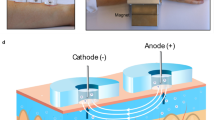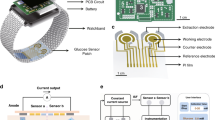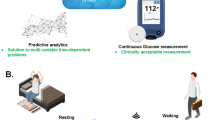Abstract
Results from the Diabetes Care and Complications Trial show that tight blood glucose control significantly reduces the long-term complications of diabetes mellitus1. In that study, frequent self-testing of glucose and insulin administration resulted in a significant reduction in long-term complications. This protocol, however, also resulted in a threefold increase in the frequency of hypoglycaemic incidents. Currently, self-testing requires a drop of blood for each measurement. The pain and inconvenience of self-testing, along with the fear and danger of hypoglycaemia has led to poor patient acceptance of a tight control regimen, despite the clear long-term advantages. A continuously worn, noninvasive method to periodically measure glucose would provide a convenient and comfortable means of frequent self-testing2,3. A continuously worn device could also alert the user of low glucose levels, thereby reducing the incidence of hypoglycaemia4,5. Guy et al. demonstrated a noninvasive method to transport glucose through the skin using low-level electrical current6,7. To provide a quantitative measurement, the flux of glucose extracted across the skin must correlate with serum glucose in a predictive manner. The results presented here show a quantitative relationship between serum and transdermally extracted glucose in diabetics.
This is a preview of subscription content, access via your institution
Access options
Subscribe to this journal
Receive 12 print issues and online access
$209.00 per year
only $17.42 per issue
Buy this article
- Purchase on Springer Link
- Instant access to full article PDF
Prices may be subject to local taxes which are calculated during checkout
Similar content being viewed by others
References
The Diabetes Control and Complications Trial Research Group. The effect of intensive treatment of diabetes on the development and progression of long-term complications in insulin-dependent diabetes mellitus. New. Engl. J. Med. 329, 977–1036 (1993).
Meyerhoff, C., Bischof, F., Sternberg, F., Zier, H. & Pfeiffer, E.F. . On line continuous monitoring of subcutaneous tissue glucose in men by combining portable glucosensor with microdialysis. Diabetologia 35, 1087–1092 (1992).
Moatti-Sirat, D. et al. Towards continuous glucose monitoring: In vivo evaluation of miniaturized glucose sensor implanted for several days in rat subcutaneous tissue. Diabetologia 35, 224–230 (1992).
Reach, G. & Wilson, G. Can continuous glucose monitoring be used for the treatment of diabetes? Analyt. Chem. 64, 381–386 (1992).
Reach, G. Continuous glucose monitoring with a subcutaneous sensor. Rationale, requirements and achievements, and prospects. in The Diabetes Annual (eds Alberti, K.G.M.M. & Home, P.D.) 332–348 (Elsevier, New York, 1993).
Glikfeld, P., Hinz, R.S. & Guy, R.H. Noninvasive sampling of biological fluids by iontophoresis. Pharmac. Res. 6, 988–990 (1989).
Rao, G. et al. Reverse iontophoresis: Noninvasive glucose monitoring in vivo in humans. Pharmac. Res. (in the press).
Clarke, W.L., Cox, D.C., Conder-Frederick, L.A., Carter, W. & Pohl, S.L. Evaluating clinical accuracy of systems for self-monitoring of blood glucose. Diabetes Care 10, 622–628 (1987).
O'Shea, T.J., Lunte, S.M. & LaCourse, W.R. Detection of carbohydrates by capillary electrophoresis with pulsed amperometric detection. Analyt. Chem. 64, 381–386 (1992).
Author information
Authors and Affiliations
Rights and permissions
About this article
Cite this article
Tamada, J., Bohannon, N. & Potts, R. Measurement of glucose in diabetic subjects using noninvasive transdermal extraction. Nat Med 1, 1198–1201 (1995). https://doi.org/10.1038/nm1195-1198
Received:
Accepted:
Published:
Issue Date:
DOI: https://doi.org/10.1038/nm1195-1198
This article is cited by
-
Flexible inorganic bioelectronics
npj Flexible Electronics (2020)
-
Bifurcation dynamics of the modified physiological model of artificial pancreas with insulin secretion delay
Nonlinear Dynamics (2011)
-
A Mediated Glucose Biosensor Incorporated with Reverse Iontophoresis Function for Noninvasive Glucose Monitoring
Annals of Biomedical Engineering (2010)
-
Alternating Current (AC) Iontophoretic Transport across Human Epidermal Membrane: Effects of AC Frequency and Amplitude
Pharmaceutical Research (2008)
-
Non-invasive monitoring of gingival crevicular fluid for estimation of blood glucose level
Medical & Biological Engineering & Computing (2004)



